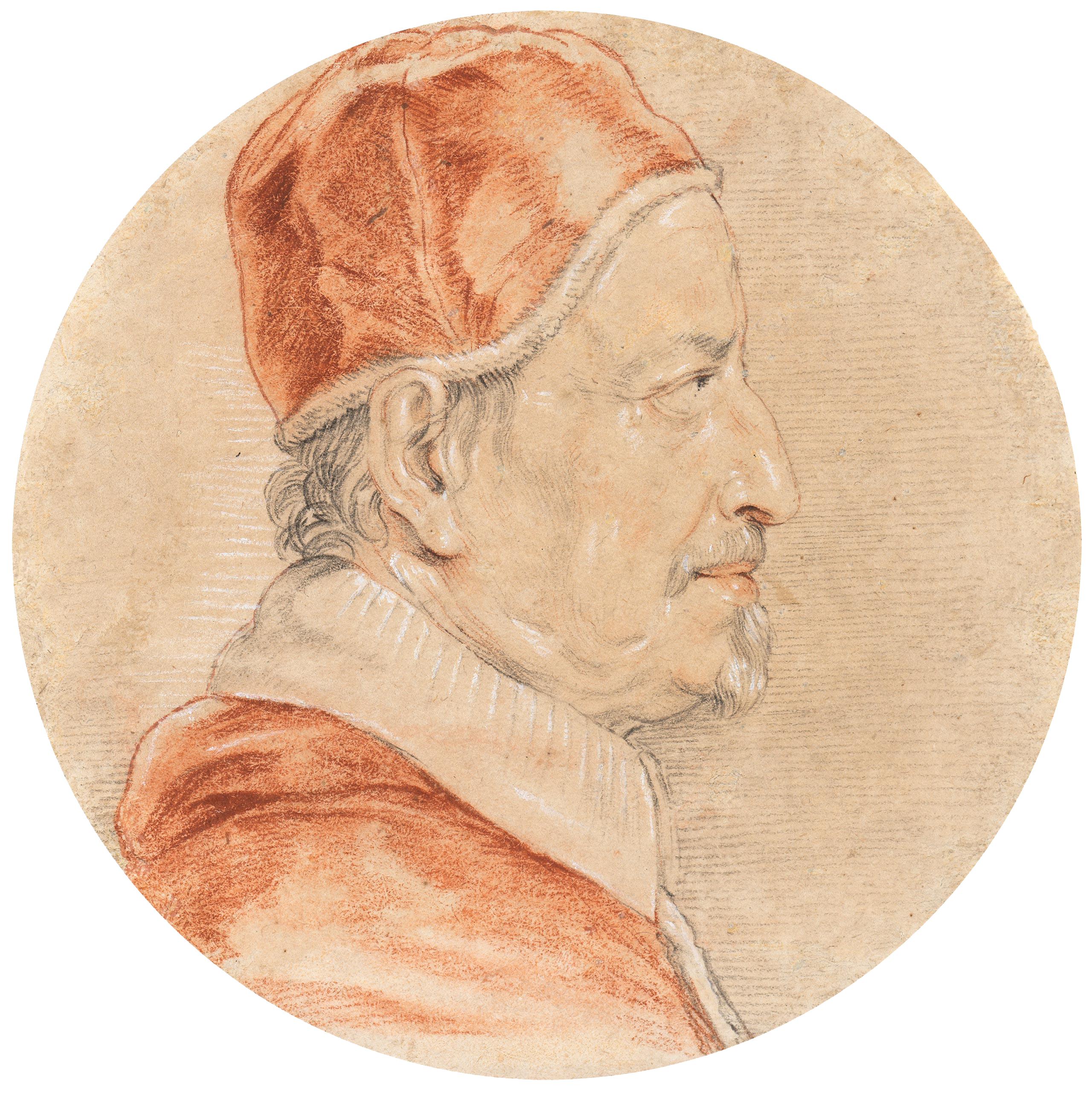
Baciccio
Giovanni Battista Gaulli, called
Genoa 1639 — Rome 1709
Portrait of Pope Innocent XII
in profile to the Right
Black, red, and white chalk on buff paper, circular.
208 mm (8 3⁄16 in.) diameter.
Christie’s London, 2nd July, 2019, lot 56, as attributed to Carlo Maratta; Mark Brady, New York, as Giovanni Battista Gaulli; private collection.
Born in Genoa, Gaulli probably trained in local workshops and practiced portraiture by studying the works of Titian, Velasquez and Piero di Cortona, but above all those of Anton van Dyck, whose portraits were numerous in the collections of the city’s patrician families. In Rome in 1657, he met Gian Lorenzo Bernini: they developed a fruitful relationship that would make Gaulli one of Rome’s most important and prolific painters of religious decors such as those for the Gesù (finished in 1684). Combining the Flemish influence absorbed in Genoa with the psychological acuity of Bernini, he perfected his own formula that would also make him one of the most sought- after portraitists by the Eternal City’s most influential figures. Gaulli executed numerous portraits and was a favorite of popes from Alexander VII to Clement XI.
His drawn portraits are rare to survive.1 Those of popes form a small group of spectacular effigies in coloured chalk: the Niedersächsisches Landesmuseum, Hannover, helds a portrait of Clement IX2 while the Royal Collection, Windsor Castle, keeps likenesses of Innocent XI and Clement X3. Gaulli portrayed Alexander VIII Ottoboni several times, full-face in a portrait preserved at the Morgan Library, New York,4 and preparatory to a painting in a private collection in Venice,5 and in profile in two drawings: one at the Museum Kunst Palast in Düsseldorf,6 the other at the Nathalie Motte Masselink gallery in 2010. Our sheet, whose distinguished profile can be identified as that of Innocent XII Pignatelli (1615-1700), has recently been recognized by the artist’s specialist Francesco Petrucci as a work by Giovanni Battista Gaulli, and is therefore a valuable addition to this corpus. At least five portraits of Innocent XII painted by Gaulli are mentioned in archival documents; they are unfortunately lost.7
Its round format and pronounced profile suggest that it was a preparatory project for a medallion portrait. In this, Gaulli follows the example set by Gian Lorenzo Bernini with his profile drawings of Alexander VII, produced in the early 1660s.8 One of them in Leipzig (Museum der Bildenden Kunste) certainly served as a model for the plaster medallion once kept in Ariccia at the Palazzo Chigi.9 Bernini drew his inspiration from Renaissance models and Baciccio followed Bernini’s example in developing a profile representation that may also have been used, after the design had been reduced, for the Vatican’s annual gold or bronze medals10, or a larger sculpted portrait such as that of Innocent XI by Paolo Morelli (1657 – 1719) in the David collection in Copenhagen.
In this portrait, flesh is treated with a veracity reminiscent of Flemish influence and Gaulli is able to render the model’s psychology with great finesse. The slight smile and the strength of the gaze express his benevolence and intelligence, two qualities that forged the pope’s reputation of honesty. Throughout his reign, Innocent XII, famous for declaring “my nephews are the poor”, refused all offices and privileges to members of his family, and fought against simony.
- F. Petrucci, Baciccio Giovanni Battista Gaulli 1639-1709, Rome, 2009, pp. 138-40.
- Ibid., p. 140, fig. 168; M. Trudzinski, Die italienischen und französischen Handzeichnungen im Kupferstichkabinett in der Landesgalerie, Hannover, 1987, cat. N° 33 (as Alexander VII).
- Royal Collection Trust: Inv. 905531, red chalk, black chalk, red wash, white heightening, 373 x 246 mm and Inv. 905533, red and black chalks, 198 x 146 mm.
- Inv. IV, 175, red and black chalk on brown paper, 371 x 244 mm.
- H. Brauer, R. Wittkower, Die Zeichnungen des Gianlorenzo Bernini, Berlin, 1931, p. 157.
- F. Petrucci, op.cit., p. 138-140, fig. 170, illustrated.
- Idem, p.171 et p. 638-639, n°E13-E17.
- F. Petrucci, “Considerazioni sui ritratti berniniani di Alessandro VII”, in A Tale for two Cities Rome and Siena in the Early Modern Period (1550-1750), Rome, 2017, p. 209, n°8.
- Idem, p. 211, n°10 et 11.
- See, for example, the one in the Metropolitan Museum by Martino Hamerani from 1691 with an allegory of charity on the reverse: Inv. 2023.569.49, gift of the Mark and Lottie Salton Trust, 2021, and also the one from 1696 with the customs of Saint Peter on the reverse (art market).

